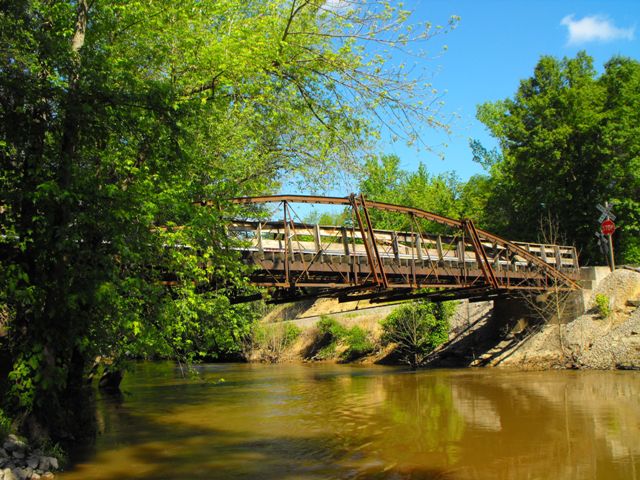We Recommend:
Bach Steel - Experts at historic truss bridge restoration.
BridgeHunter.com Phase 1 is released to the public! - Visit Now
CR-650 East Bridge
Pike County Bridge 150

Primary Photographer(s): Nathan Holth and Rick McOmber
Bridge Documented: May 9, 2010
Rural: Pike County, Indiana: United States
1875 By Builder/Contractor: Smith Bridge Company of Toledo, Ohio (Design, Fabricator) and William T. Washer of Troy, Indiana (Builder)
1978
88.0 Feet (26.8 Meters)
98.8 Feet (30.1 Meters)
10.2 Feet (3.11 Meters)
1 Main Span(s)
6300101

View Information About HSR Ratings
Bridge Documentation
This bridge is extremely significant as not only what may be the last example of a bowstring bridge built by its builder but also for its distinctive details that set this bowstring apart from bowstrings built by other companies. The most noteworthy detail of this bowstring is its unusual top chord which is composed of back-to-back angles with corrugation running between them. A similar detail is found on the beams under the deck that support the outriggers. Because of the unusual composition of the top chord, unique cast iron connection assemblies were used to form the top chord connections. These castings are located between the channels and are riveted to the channels. These assemblies have holes that allow the vertical and diagonal members to make a connection with the top chord via the threaded rod and nut method. Threaded rod and nut connections were common during this period. The remainder of this bridge is more traditional in terms of a bowstring truss bridge. Cast iron connection assemblies are located along the bottom chord, and the bottom chord is composed of plates with eyebars where pin-connected splices occur. Vertical members and outriggers use the cruciform beams or "star iron" that was common in the 1870s and on bowstring truss bridges.
All of the aforementioned details survive on the bridge in good condition. The bridge however has been altered by the rather unsightly addition of a supplemental structure that bears part of the load. It is worth noting however that these alterations appear to be reversible and do not appear to have resulted in the loss of original bridge material, so one cannot really condemn these changes to the bridge, even if they do reduce the visual quality of the bridge.
Historic bridge expert James L. Cooper invested considerable time and research to unravel the mystery of this bridge. It had for many years been uncertain who built the bridge and when. His research revealed that the bridge was built in 1875 by the Smith Bridge Company of Toledo, Ohio, with noteworthy regional bridge contractor William T. Washer of Troy in Perry County being the on-site contractor for the substructure and bridge erection. Please view Cooper's complete report for an outstanding... and far more complete... exploration of this bridge's history, design, and significance.
View Archived National Bridge Inventory Report - Has Additional Details and Evaluation
This historic bridge was relocated and preserved in Petersburg. View This Bridge's Petersburg Page Here.
View A Detailed Study and Report of This Bridge By James L. Cooper
Information and Findings From DHPA Historic Bridge SurveyStatement of Significance The county's consulting engineers (1980) are correct to consider this "a unique structure of historical importance." The arch is unusually fabricated, the single example of its kind extant in Indiana. The unadorned structure retains most of its original members, although the original structure now carries only a part of the stress. The only firm known to have used the ribbon lacing found here in the chord arches was the Indianapolis Bridge Company. Architectural Description This single-span bowstring pony of 94' and ten panels was rebuilt in 1978. Now seated upon concrete abutments and wingwalls, some of the weight of the revised structure is carried by a substantial wood beam superstructure. The original arches are fabricated from channel beams laced together in ten sections which were then riveted. Cruciform-shaped verticals and cylindrical eyebar diagonals (crossed in all except the endpost panels) are bolted through the arch and the lower chord. Two die-forged rectangular eyebars comprise the lower chord and were bolted to the original floor beams of die-forged rectangular eyebars laced together. Alterations Now seated upon concrete abutments and wingwalls, some of the weight of the revised structure (1978) is carried by a substantial wood beam superstructure resting upon channel beams and reinforcing channel floor beams attached below the lower chord. Therefore, although the unadorned structure retains most of its original members, the original structure now carries only a part of the stress. Bibliography Ohio Valley Engineers, Bridge Inspection Survey and
Report: Pike County (Evansville, 1974). Bridge Considered Historic By Survey: Yes |
![]()
Photo Galleries and Videos: CR-650 East Bridge
Bridge Photo-Documentation
Original / Full Size PhotosA collection of overview and detail photos. This gallery offers photos in the highest available resolution and file size in a touch-friendly popup viewer.
Alternatively, Browse Without Using Viewer
![]()
Bridge Photo-Documentation
Mobile Optimized PhotosA collection of overview and detail photos. This gallery features data-friendly, fast-loading photos in a touch-friendly popup viewer.
Alternatively, Browse Without Using Viewer
![]()
Maps and Links: CR-650 East Bridge
Coordinates (Latitude, Longitude):
Search For Additional Bridge Listings:
Bridgehunter.com: View listed bridges within 0.5 miles (0.8 kilometers) of this bridge.
Bridgehunter.com: View listed bridges within 10 miles (16 kilometers) of this bridge.
Additional Maps:
Google Streetview (If Available)
GeoHack (Additional Links and Coordinates)
Apple Maps (Via DuckDuckGo Search)
Apple Maps (Apple devices only)
Android: Open Location In Your Map or GPS App
Flickr Gallery (Find Nearby Photos)
Wikimedia Commons (Find Nearby Photos)
Directions Via Sygic For Android
Directions Via Sygic For iOS and Android Dolphin Browser
USGS National Map (United States Only)
Historical USGS Topo Maps (United States Only)
Historic Aerials (United States Only)
CalTopo Maps (United States Only)

